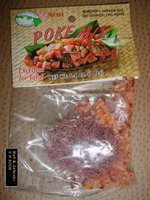Friday was a very rainy day and Saturday morning we awoke to a beautiful sunny day.
From our place, Mt Koya is a two hour train ride, 5 minute cable lift ride and 10 minute bus ride away. We bought the
Nankai Mt Koya free subic (I'm not too sure about the spelling or what it means but in katakana it is pronounced koyasan furee saabick) ticket for 2780 yen per person (about US$30). This fee included the cable lift, and round trip train ride, off and on privileges for the bus, plus, discounted entrance fees to some of the temples, museums and discounts at some gift shops.
Mt Koya is located in the Northern part of Wakayama prefecture about 1000m above sea level. The
Shingon(True Word) sect founded in 816 by Kobo Daishi has a huge religious retreat here. If you want to truly experience everything, it is best to stay a night at one of the
shukubo (missions).
From
Gokuraku station, you need to ride the cable lift up to the top of Mt Koya. At the top, there are buses waiting to take you to the retreat area.

The first place we stopped at was for lunch. One of the things you have to try is the
goma tofu (sesame curd). I won't tell you the name of the restaurant because the one that we ate here was a bit bland to me, a better goma tofu would have been really fragrant from the sesame seed paste that is used to make it.

Next we walked to
Okunoin. This area is a huge cemetery with very old and large
sugi (cedar). It is a very tranquil place. One of the people buried here is Tokugawa Ieyasu, a famous
shogun (Japanese general). Kobo Daishi is also said to be in "eternal meditation" in the cave of Okunoin waiting for the Buddha of the Future to meet him. Other people also want to be "invited" to attend this meeting, so they are also buried at Okunoin, waiting along side of Kobo Daishi.


There were some interesting headstones here, and many companies have graves here also. Take for example, the UCC coffee company. And the astronaut association. Satoshi and I overheard a guide say that most companies have graves here but it is also a good way to advertise for them.

At Okunoin, we were able to see a group of monks. There were a lot of interesting artifacts inside of Okunoin, but no photos were allowed.

From Okunoin, we took the bus to
Karukaya-do and walked the main street. We stopped at
Shoeido for some
yakimochi (grilled rice cakes).

We tried the
yomogi (mugwort) and plain--both were filled with
tsubu-an (chunky sweet bean paste), just off the grill...delicious.

We then walked to
Kongobuji. This temple was built by
Toyotomi Hideyoshi (a Japanese warlord). There was a free tea ticket with our transportation, so we were able to enjoy a little tea break here.

This temple also had a very nice rock garden.

And a very old kitchen area that was still being used.

Nearby Kongobuji is the
Konpondaito. This pagoda is 48.5m tall and situated in the center of Mt Koya. Again, no photos were allowed, so I could only get a shot of what was on the outside.
At most places, you are required to take off your shoes. I thought this sign was funny...."off shoes, off"....


At many of these temples you can get your prayer books stamped and then something written by the monks. These ladies happened to be doing just that and apparently, many people travel all around Japan getting these stamps and calligraphic writings....kind of like an autograph book of sorts.
Next to Konpondaito is
Kondo Hall. This is actually the 7th reconstruction of the building. Sorry, I didn't take a photo of it.

From Kondo Hall, we walked to
Daimon. This HUGE gate stands at the main entrance to Mt Koya. I had to walk across the street to get the whole thing in!
From Daimon, we walked to the
Reihokan. This building displays many National Treasures. Again, no photos allowed.
From the Reihokan it is about a two minute walk to
Daishi Hall, this is where all that want to become Daishi missionaries come.

We caught a bus from Daishi Hall to Namikirifudomae. This is where the Tokugawa Family Tomb is. In the front of the tomb is a temple called
Namikirifudo, here there is an awesome dragon covering the ceiling. To tell you the truth, we were a bit disappointed with the Tokugawa Family Tomb. Admission is 200 yen (about US$2) and there wasn't much to see because the tomb is fenced in.

We then caught the bus to
Nyonin-do. Nyonin-do is where all the women who came to Mt Koya were allowed to stay and worship. Apparently, they weren't allowed into the retreat area until 1872. This shot is of the entry way--all women were to stay behind this gate. (There used be 7 other entry ways, but this is the only one still in tact.)

Then it was time to return to the hustle and bustle...we took the bus back to Mt Koya station to catch the cable lift down the steep mountain.

Since the cable lift uses one rail, there is a point where you pass another car.

Here are some
omiyage (souvenirs) that we bought--goma tofu and
ume (pickled plums). (Wakayama prefecture is also known for their ume.) I hope this goma tofu is better than the one I had for lunch.

After all that walking I felt like this little guy...I hope you enjoyed our adventure as much as we did.
Have a great week.
 Oroshinose-yakinikudon (grilled marinated meat bowl with grated daikon on top) Serves 2
Oroshinose-yakinikudon (grilled marinated meat bowl with grated daikon on top) Serves 2 Celery no kim chee ae (Celery dressed with kim chee) Serves 2
Celery no kim chee ae (Celery dressed with kim chee) Serves 2
















































